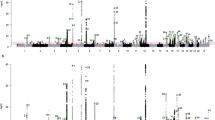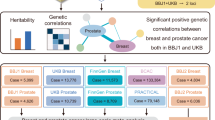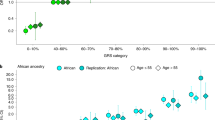Abstract
The international Testicular Cancer Consortium (TECAC) combined five published genome-wide association studies of testicular germ cell tumor (TGCT; 3,558 cases and 13,970 controls) to identify new susceptibility loci. We conducted a fixed-effects meta-analysis, including, to our knowledge, the first analysis of the X chromosome. Eight new loci mapping to 2q14.2, 3q26.2, 4q35.2, 7q36.3, 10q26.13, 15q21.3, 15q22.31, and Xq28 achieved genome-wide significance (P < 5 × 10−8). Most loci harbor biologically plausible candidate genes. We refined previously reported associations at 9p24.3 and 19p12 by identifying one and three additional independent SNPs, respectively. In aggregate, the 39 independent markers identified to date explain 37% of father-to-son familial risk, 8% of which can be attributed to the 12 new signals reported here. Our findings substantially increase the number of known TGCT susceptibility alleles, move the field closer to a comprehensive understanding of the underlying genetic architecture of TGCT, and provide further clues to the etiology of TGCT.
This is a preview of subscription content, access via your institution
Access options
Access Nature and 54 other Nature Portfolio journals
Get Nature+, our best-value online-access subscription
$29.99 / 30 days
cancel any time
Subscribe to this journal
Receive 12 print issues and online access
$209.00 per year
only $17.42 per issue
Buy this article
- Purchase on Springer Link
- Instant access to full article PDF
Prices may be subject to local taxes which are calculated during checkout


Similar content being viewed by others
References
Trabert, B., Chen, J., Devesa, S.S., Bray, F. & McGlynn, K.A. International patterns and trends in testicular cancer incidence, overall and by histologic subtype, 1973–2007. Andrology 3, 4–12 (2015).
Howlader, N. et al. SEER Cancer Statistics Review, 1975–2012 (National Cancer Institute, 2015).
Znaor, A., Lortet-Tieulent, J., Jemal, A. & Bray, F. International variations and trends in testicular cancer incidence and mortality. Eur. Urol. 65, 1095–1106 (2014).
Bromen, K. et al. Testicular, other genital, and breast cancers in first-degree relatives of testicular cancer patients and controls. Cancer Epidemiol. Biomarkers Prev. 13, 1316–1324 (2004).
Chia, V.M. et al. Risk of cancer in first- and second-degree relatives of testicular germ cell tumor cases and controls. Int. J. Cancer 124, 952–957 (2009).
Heimdal, K. et al. Risk of cancer in relatives of testicular cancer patients. Br. J. Cancer 73, 970–973 (1996).
Sonneveld, D.J. et al. Familial testicular cancer in a single-centre population. Eur. J. Cancer 35, 1368–1373 (1999).
McGlynn, K.A. & Trabert, B. Adolescent and adult risk factors for testicular cancer. Nat. Rev. Urol. 9, 339–349 (2012).
Litchfield, K. et al. Quantifying the heritability of testicular germ cell tumour using both population-based and genomic approaches. Sci. Rep. 5, 13889 (2015).
Mucci, L.A. et al. Familial risk and heritability of cancer among twins in Nordic countries. J. Am. Med. Assoc. 315, 68–76 (2016).
Crockford, G.P. et al. Genome-wide linkage screen for testicular germ cell tumour susceptibility loci. Hum. Mol. Genet. 15, 443–451 (2006).
Chung, C.C. et al. Meta-analysis identifies four new loci associated with testicular germ cell tumor. Nat. Genet. 45, 680–685 (2013).
Kanetsky, P.A. et al. Common variation in KITLG and at 5q31.3 predisposes to testicular germ cell cancer. Nat. Genet. 41, 811–815 (2009).
Kanetsky, P.A. et al. A second independent locus within DMRT1 is associated with testicular germ cell tumor susceptibility. Hum. Mol. Genet. 20, 3109–3117 (2011).
Schumacher, F.R. et al. Testicular germ cell tumor susceptibility associated with the UCK2 locus on chromosome 1q23. Hum. Mol. Genet. 22, 2748–2753 (2013).
Rapley, E.A. et al. A genome-wide association study of testicular germ cell tumor. Nat. Genet. 41, 807–810 (2009).
Turnbull, C. et al. Variants near DMRT1, TERT and ATF7IP are associated with testicular germ cell cancer. Nat. Genet. 42, 604–607 (2010).
Kristiansen, W. et al. Two new loci and gene sets related to sex determination and cancer progression are associated with susceptibility to testicular germ cell tumor. Hum. Mol. Genet. 24, 4138–4146 (2015).
Litchfield, K. et al. Identification of four new susceptibility loci for testicular germ cell tumour. Nat. Commun. 6, 8690 (2015).
Ruark, E. et al. Identification of nine new susceptibility loci for testicular cancer, including variants near DAZL and PRDM14. Nat. Genet. 45, 686–689 (2013).
Litchfield, K. et al. Multi-stage genome-wide association study identifies new susceptibility locus for testicular germ cell tumour on chromosome 3q25. Hum. Mol. Genet. 24, 1169–1176 (2015).
Nathanson, K.L. et al. The Y deletion gr/gr and susceptibility to testicular germ cell tumor. Am. J. Hum. Genet. 77, 1034–1043 (2005).
Dalgaard, M.D. et al. A genome-wide association study of men with symptoms of testicular dysgenesis syndrome and its network biology interpretation. J. Med. Genet. 49, 58–65 (2012).
Wakefield, J. A Bayesian measure of the probability of false discovery in genetic epidemiology studies. Am. J. Hum. Genet. 81, 208–227 (2007).
Wong, Y.H. et al. Protogenin defines a transition stage during embryonic neurogenesis and prevents precocious neuronal differentiation. J. Neurosci. 30, 4428–4439 (2010).
Unsal-Kaçmaz, K. et al. The human Tim/Tipin complex coordinates an jntra-S checkpoint response to UV that slows replication fork displacement. Mol. Cell. Biol. 27, 3131–3142 (2007).
Williams, B.C. et al. Zwilch, a new component of the ZW10/ROD complex required for kinetochore functions. Mol. Biol. Cell 14, 1379–1391 (2003).
Almstrup, K. et al. Embryonic stem cell–like features of testicular carcinoma in situ revealed by genome-wide gene expression profiling. Cancer Res. 64, 4736–4743 (2004).
Sonne, S.B. et al. Analysis of gene expression profiles of microdissected cell populations indicates that testicular carcinoma in situ is an arrested gonocyte. Cancer Res. 69, 5241–5250 (2009).
Tang, W.W. et al. A unique gene regulatory network resets the human germline epigenome for development. Cell 161, 1453–1467 (2015).
Kristensen, D.M. et al. Presumed pluripotency markers UTF-1 and REX-1 are expressed in human adult testes and germ cell neoplasms. Hum. Reprod. 23, 775–782 (2008).
Scotland, K.B., Chen, S., Sylvester, R. & Gudas, L.J. Analysis of Rex1 (zfp42) function in embryonic stem cell differentiation. Dev. Dyn. 238, 1863–1877 (2009).
Yokoi, F., Hiraishi, H. & Izuhara, K. Molecular cloning of a cDNA for the human phospholysine phosphohistidine inorganic pyrophosphate phosphatase. J. Biochem. 133, 607–614 (2003).
Kim, J.H. et al. The condensin component NCAPG2 regulates microtubule–kinetochore attachment through recruitment of Polo-like kinase 1 to kinetochores. Nat. Commun. 5, 4588 (2014).
Schwaab, J. et al. Expression of Transketolase like gene 1 (TKTL1) predicts disease-free survival in patients with locally advanced rectal cancer receiving neoadjuvant chemoradiotherapy. BMC Cancer 11, 363 (2011).
Ahopelto, K., Böckelman, C., Hagström, J., Koskensalo, S. & Haglund, C. Transketolase-like protein 1 expression predicts poor prognosis in colorectal cancer. Cancer Biol. Ther. 17, 163–168 (2016).
Jayachandran, A. et al. Transketolase-like 1 ectopic expression is associated with DNA hypomethylation and induces the Warburg effect in melanoma cells. BMC Cancer 16, 134 (2016).
Kayser, G. et al. Poor outcome in primary non–small cell lung cancers is predicted by transketolase TKTL1 expression. Pathology 43, 719–724 (2011).
Eichler, E.E. et al. Complex β-satellite repeat structures and the expansion of the zinc finger gene cluster in 19p12. Genome Res. 8, 791–808 (1998).
Mangino, M. et al. Genome-wide meta-analysis points to CTC1 and ZNF676 as genes regulating telomere homeostasis in humans. Hum. Mol. Genet. 21, 5385–5394 (2012).
Auton, A. et al. A global reference for human genetic variation. Nature 526, 68–74 (2015).
Jiao, S. et al. Estimating the heritability of colorectal cancer. Hum. Mol. Genet. 23, 3898–3905 (2014).
Mancuso, N. et al. The contribution of rare variation to prostate cancer heritability. Nat. Genet. 48, 30–35 (2016).
Michailidou, K. et al. Genome-wide association analysis of more than 120,000 individuals identifies 15 new susceptibility loci for breast cancer. Nat. Genet. 47, 373–380 (2015).
Park, J.H. et al. Estimation of effect size distribution from genome-wide association studies and implications for future discoveries. Nat. Genet. 42, 570–575 (2010).
Hemminki, K. & Li, X. Familial risk in testicular cancer as a clue to a heritable and environmental aetiology. Br. J. Cancer 90, 1765–1770 (2004).
Purcell, S. et al. PLINK: a tool set for whole-genome association and population-based linkage analyses. Am. J. Hum. Genet. 81, 559–575 (2007).
Delaneau, O., Zagury, J.F. & Marchini, J. Improved whole-chromosome phasing for disease and population genetic studies. Nat. Methods 10, 5–6 (2013).
Howie, B.N., Donnelly, P. & Marchini, J. A flexible and accurate genotype imputation method for the next generation of genome-wide association studies. PLoS Genet. 5, e1000529 (2009).
Li, B. & Dewey, C.N. RSEM: accurate transcript quantification from RNA–Seq data with or without a reference genome. BMC Bioinformatics 12, 323 (2011).
Acknowledgements
The content of this publication does not necessarily reflect the views or policies of the Department of Health and Human Services nor does the mention of trade names, commercial products, or organizations indicate endorsement by the US government. We thank B. Weathers for her coordination of TECAC, J. Pluta for biostatistical assistance, and K. D'Andrea for expert assistance with SNP genotyping. We thank D.R. Stewart and J.T. Loud for critical support of the NCI Clinical Genetics Branch Familial Testicular Cancer Project (NCI 02-C-0178; NCT-00039598). We also thank all previous contributors to the GWAS analyzed in this study, including N. Weinhold, D. Edsgärd, H. Leffers, and A. Juul, N.E. Skakkebæk, and S. Brunak from the Danish study.
The Testicular Cancer Consortium is supported by National Institutes of Health grant U01CA164947 to K.L.N., P.A.K., and S.M.S. A portion of this work was supported by the Intramural Research Program of the National Cancer Institute and by support services contract HHSN26120130003C with IMS, Inc. The Penn GWAS (Penn) was supported by the Abramson Cancer Center at the University of Pennsylvania and National Institute of Health grant CA114478 to K.L.N. and P.A.K. The UK testicular cancer study was supported by the Institute of Cancer Research, Cancer Research UK, and made use of control data generated by the Wellcome Trust Case Control Consortium 2 (WTCCC2). C.T. is supported by the Movember Foundation. K.L. is supported by a PhD fellowship from Cancer Research UK. L.C.P. is supported by the National Institutes of Health (T32-GM008638). The contribution from the University of Leeds was funded by Cancer Research UK (C588/A19167). The Norwegian/Swedish study was supported by the Norwegian Cancer Society (grants 418975–71081–PR-2006-0387 and PK01-2007-0375); the Nordic Cancer Union (grant S-12/07), and the Swedish Cancer Society (grants 2008/708, 2010/808, 2011/484, and CAN2012/823). The Danish GWAS was supported by the Villum Kann Rasmussen Foundation, a NABIIT grant from the Danish Strategic Research Council, the Novo Nordisk Foundation, the Danish Cancer Society, and the Danish and Swedish Childhood Cancer Foundation.
Author information
Authors and Affiliations
Consortia
Contributions
K.L.N. and P.A.K. supervised the overall study. K.A.M., E.R.-D.M., D.T.B., M.D.D., M.H.G., R.G., T.G., T.B.H., K.L., K.N., S.M.S., F.W., C.T., P.A.K., and K.L.N. contributed to recruitment and to study, data management. Z.W., K.A.M., E.R.-D.M., D.T.B., M.D.D., M.H.G., R.G., T.G., T.B.H., R.K., K.L., N.M., K.N., S.V., F.W., C.T., S.J.C., P.A.K., and K.L.N. contributed to genotyping or association analysis of individual studies. Z.W., C.C.C., L.C.P., V.T., S.J.C., P.A.K., and K.L.N. carried out the meta-analysis and the additional bioinformatics analyses, including using GTEx and TCGA TGCT data. Z.W., P.A.K., and K.L.N. drafted the initial manuscript, and all authors reviewed and contributed to the manuscript.
Corresponding author
Ethics declarations
Competing interests
The authors declare no competing financial interests.
Supplementary information
Supplementary Text and Figures
Supplementary Figures 1–6 and Supplementary Tables 1–7 (PDF 6647 kb)
Rights and permissions
About this article
Cite this article
Wang, Z., McGlynn, K., Rajpert-De Meyts, E. et al. Meta-analysis of five genome-wide association studies identifies multiple new loci associated with testicular germ cell tumor. Nat Genet 49, 1141–1147 (2017). https://doi.org/10.1038/ng.3879
Received:
Accepted:
Published:
Issue Date:
DOI: https://doi.org/10.1038/ng.3879
This article is cited by
-
Implementation of individualised polygenic risk score analysis: a test case of a family of four
BMC Medical Genomics (2022)
-
Predicted leukocyte telomere length and risk of germ cell tumours
British Journal of Cancer (2022)
-
A common deletion at BAK1 reduces enhancer activity and confers risk of intracranial germ cell tumors
Nature Communications (2022)
-
Promoter-interacting expression quantitative trait loci are enriched for functional genetic variants
Nature Genetics (2021)
-
Small fraction of testicular cancer cases may be causatively related to CHEK2 inactivating germ-line mutations: evidence for somatic loss of the remaining CHEK2 allele in the tumor tissue
Familial Cancer (2021)



